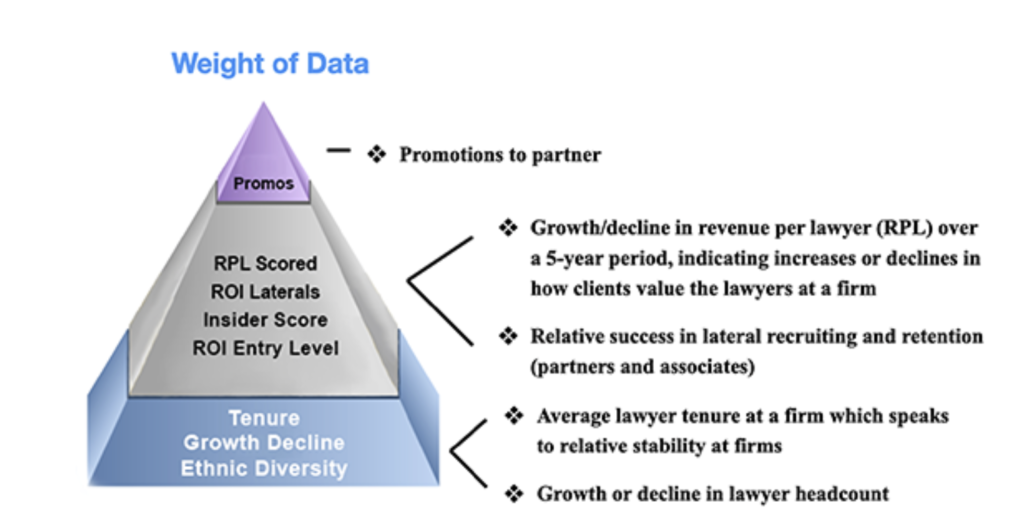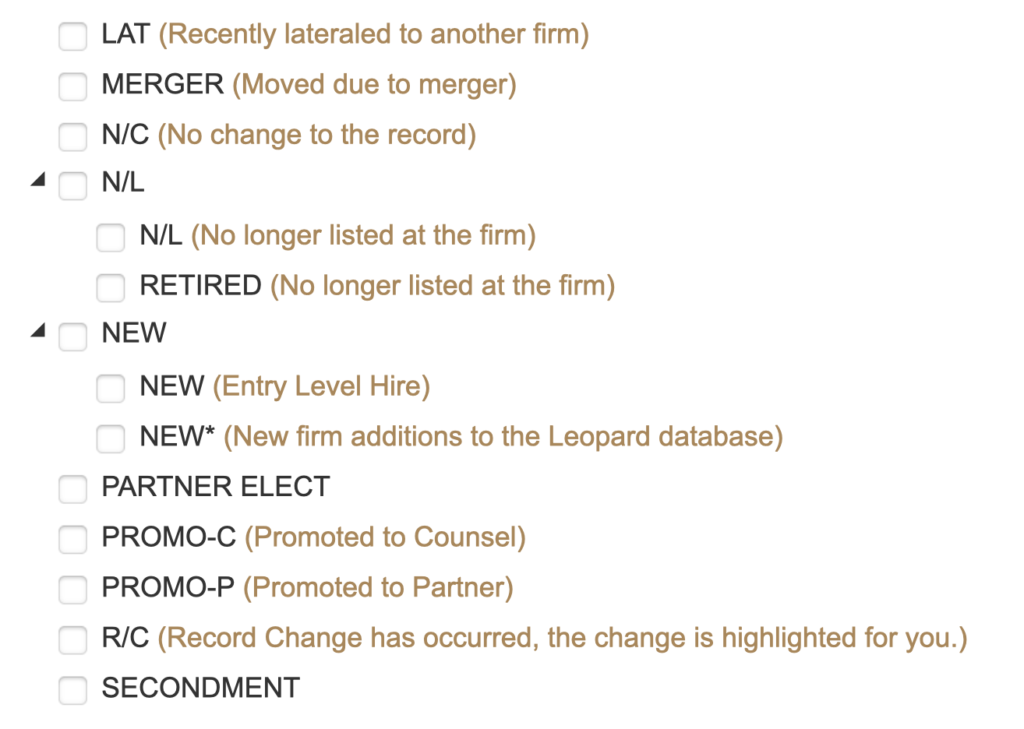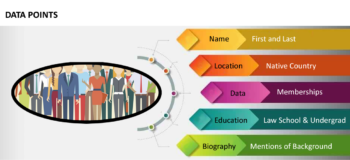Leopard Solutions typically follows corporate law firms with 5 or more attorneys.
LLFI stands for Leopard Law Firm Index. This is a dynamic rating system applied to all law firms in our database, based on uncompromised, qualitative datasets that are numeric and weighted proportionately to the size of the firm. LLFI 250 is the Leopard Law Firm Index Top 250 ranking. The top rankings are compiled of the largest firms (at least 125 attorneys) with at least a GOOD or VERY GOOD rating.
We are currently measuring the items below. Our own attorney data informs us of growth/decline numbers, hiring, retention and promotions. These numbers can change each week and if a large enough change has occurred, the index would reflect it.

The Leopard Law Firm Index was developed to better reflect the overall stability of a firm using data far beyond financial metrics. We compile data points that we believe speak to a firm’s strengths and weaknesses in an effort to give greater insight into the legal landscape.
Benchmark firms by the index metrics in the Leopard BI Firm Index Report
View a firm’s index score in their Firmscape Report.
Search for firms by their LLFI ranking (LLFI 50, 100, 200 or 250) by using the Firm Rank Filter on any Firmscape Report
Search for candidates at LLFI ranked firms (LLFI 50, 100, 200 or 250) by using the Firm Filter in Leopard List
Search for jobs at LLFI ranked firms (LLFI 50, 100, 200 or 250) using the Firm Filter in Job Search
You can see the publicly available list of our Top 250 firms Here.
Every attorney has a Status Code to indicate any changes that have been made to the record. Status codes remain active for 90 days before reverting to N/C (no change).

Changes to the attorney record over time can be tracked through the Status Codes. To view attorney history in Leopard List or InHouse, click the ![]() icon. To view in Firmscape or Leopard BI, first click the hyperlinked number to view the attorneys, then click History.
icon. To view in Firmscape or Leopard BI, first click the hyperlinked number to view the attorneys, then click History.
The platform is being fed by the information from Leopard List.
Leopard List is updated every Tuesday and Thursday of every week.
Because Frimscape and Leopard BI are being fed by Leopard List, the Firmscape and Leopard BI platforms are updated every Tuesday and Thursday of every week as well.
Leopard In-House is not as granular as the other platforms. However, we are checking those attorney’s records at least four times per year. And that whole platform is being updated on a rolling basis.
Leopard Jobs is being updated throughout the day.
The basic data is gathered from the firm website . Our attorney team looks at each and every bio to determine exactly what the attorney does and they use our practice area and specialties to relay that information to our clients. If the law school, JD or practice is missing on the bio, our team researches the answer. We use publicly available information, eg LinkedIn, Bar Association website, press releases etc. to complete the required information. We update the Leopard List twice a week on Tuesday and Thursday.
We are determining the probability of diversity by reviewing the attorney bios and using multiple data points. They are being carefully researched from within our own dataset and other materials. Data points are accessed, accumulated, and counted toward the result of being either a low or high probability of being diverse.

This is Leopard Solutions’ own algorithm based on historical data. We analyzed 17 years’ worth of attorney lateral movement to see if there were specific aspects that made an attorney more or less likely to move. This analysis five data points that go into our statistical model;
Data analysis showed us how these factors converged in the past for attorneys who made a lateral move, and we apply that knowledge to the Probability of Move algorithm.
The labels (Low, Medium, High, Very High) depend on the type of attorney. 20% is Very High for a Partner or Counsel, whereas 38% is Very High for an Associate.
Leopard Solutions uses an algorithm to project Firm Financials for non-AmLaw reporting firms. Our algorithm was devised using 15 years’ worth of publicly reported financials as a data set. Based on the structure of the firm, headcount, balance of associates, partners and counsel, locations, and practice areas, we project out financials and update those periodically throughout the year. As a benchmark that we apply to all non-AmLaw firms, it provides a useful comparison.
Projected Financials are calculated for the US region only, and no historical data is available or displayed.
Administrators can easily add or remove users in the Admin panel that we provide. Once you have entered the panel, just click to deactivate or add a user. You can also reset a password from here.


This is Leopard Solutions’ own algorithm based on historical data. We analyzed 17 years’ worth of attorney lateral movement to see if there were specific aspects that made an attorney more or less likely to move. This analysis five data points that go into our statistical model;
Data analysis showed us how these factors converged in the past for attorneys who made a lateral move, and we apply that knowledge to the Probability of Move algorithm.
The labels (Low, Medium, High, Very High) depend on the type of attorney. 20% is Very High for a Partner or Counsel, whereas 38% is Very High for an Associate.
LLFI stands for Leopard Law Firm Index. This is a dynamic rating system applied to all law firms in our database, based on uncompromised, qualitative datasets that are numeric and weighted proportionately to the size of the firm. LLFI 250 is the Leopard Law Firm Index Top 250 ranking. The top rankings are compiled of the largest firms (at least 125 attorneys) with at least a GOOD or VERY GOOD rating.
We are currently measuring the items below. Our own attorney data informs us of growth/decline numbers, hiring, retention and promotions. These numbers can change each week and if a large enough change has occurred, the index would reflect it.

The Leopard Law Firm Index was developed to better reflect the overall stability of a firm using data far beyond financial metrics. We compile data points that we believe speak to a firm’s strengths and weaknesses in an effort to give greater insight into the legal landscape.
Benchmark firms by the index metrics in the Leopard BI Firm Index Report
View a firm’s index score in their Firmscape Report.
Search for firms by their LLFI ranking (LLFI 50, 100, 200 or 250) by using the Firm Rank Filter on any Firmscape Report
Search for candidates at LLFI ranked firms (LLFI 50, 100, 200 or 250) by using the Firm Filter in Leopard List
Search for jobs at LLFI ranked firms (LLFI 50, 100, 200 or 250) using the Firm Filter in Job Search
You can see the publicly available list of our Top 250 firms Here.
This is Leopard Solutions’ own algorithm based on historical data. We analyzed 17 years’ worth of attorney lateral movement to see if there were specific aspects that made an attorney more or less likely to move. This analysis five data points that go into our statistical model;
Data analysis showed us how these factors converged in the past for attorneys who made a lateral move, and we apply that knowledge to the Probability of Move algorithm.
The labels (Low, Medium, High, Very High) depend on the type of attorney. 20% is Very High for a Partner or Counsel, whereas 38% is Very High for an Associate.
Leopard Solutions uses an algorithm to project Firm Financials for non-AmLaw reporting firms. Our algorithm was devised using 15 years’ worth of publicly reported financials as a data set. Based on the structure of the firm, headcount, balance of associates, partners and counsel, locations, and practice areas, we project out financials and update those periodically throughout the year. As a benchmark that we apply to all non-AmLaw firms, it provides a useful comparison.
Projected Financials are calculated for the US region only, and no historical data is available or displayed.
Leopard Solutions uses an algorithm to project Firm Financials for non-AmLaw reporting firms. Our algorithm was devised using 15 years’ worth of publicly reported financials as a data set. Based on the structure of the firm, headcount, balance of associates, partners and counsel, locations, and practice areas, we project out financials and update those periodically throughout the year. As a benchmark that we apply to all non-AmLaw firms, it provides a useful comparison.
Projected Financials are calculated for the US region only, and no historical data is available or displayed.
Copyright © 2025 Leopard Solutions, a SurePoint company. All rights reserved